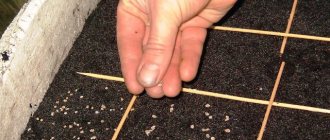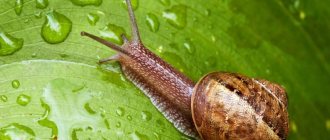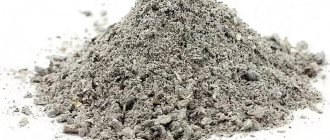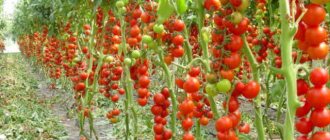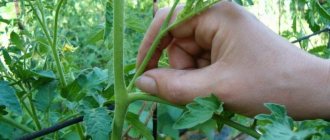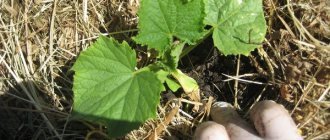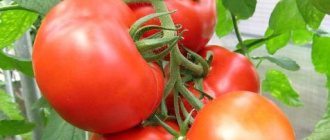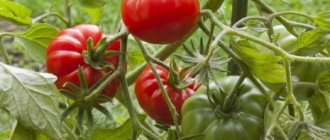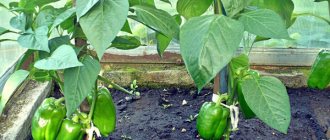What conditions does the cucumber plant like?
Cucumbers are greenhouse plants. Summer residents mainly grow cucumbers in a polycarbonate greenhouse. The question of what other crops can be planted in the greenhouse next to them depends on what conditions the cucumber plants prefer.
Cucumbers love heat very much. They also prefer good lighting. Variability of weather conditions and temperature fluctuations mainly frighten them. The greenhouse should be fairly humid; they prefer a humid climate. Frequent watering for cucumbers in a greenhouse is required. Cucumbers also grow well only on fertile soil, which must be periodically loosened and fertilized. Humus and manure have a good effect on them, but an excess of nitrogen impairs fruiting.
Therefore, you can plant next to them only those plants that have similar needs, so that they are easier to care for . This is the only way to achieve a good harvest. It is worth noting that not all crops get along well with cucumbers. Some only prevent them from growing.
The nuances of joint cultivation
Beginning gardeners usually build only one greenhouse , and then try to fit as many crops as possible into it. The main arguments in favor of this approach are saving space and reducing the cost of maintaining the structure. However, placing some types of vegetables together will frustrate novice vegetable growers.
Among the risk factors:
- different requirements for temperature, lighting and humidity levels;
- the need to apply different fertilizers;
- the possibility of damage by pests that prefer certain plants and are able to spread to neighboring crops;
- danger of cross-pollination.
The result of incorrect placement can be a significant reduction in yield, slowdown in plant development, massive shedding of ovaries and even the death of individual specimens.
What to plant next to cucumbers
Cucumbers tend to cling to any object with their antennae. And so that they do not damage neighboring plants, they should be grown on a trellis in a greenhouse.
To cucumbers you can add dill, parsley, basil, fennel, leaf and head lettuce, white cabbage (of course, if there is enough space for it), radish, eggplant (varieties Siberian early ripening 148, Mushroom Picker's Dream), sweet pepper (Giganto Rossa F1 , Ural thick-walled F1, Yellow giant F1, Red giant F1, Orange giant F1, Dutch giant, Queen Elizabeth F1).
Eggplant
Crops have similar requirements for watering and care. When growing them together, you need to provide the cucumbers with supports for the vines in time, then they will not oppress each other. If you plant eggplants in a greenhouse together with cucumbers, then plant the eggplants in a sunny place first, since the wide leaves of cucumbers can shade them.
Will bell peppers grow along with cucumbers?
This is another advantageous neighborhood. Peppers like the same growing conditions as cucumbers. They do not tolerate drafts, dry soils and dry, hot air. Just tie up the vines so as not to shade the nightshade crop. Cabbage and peppers are also excellent predecessors for garden beds in front of cucumbers.
Here's what you can plant in a greenhouse with cucumbers
Zucchini
Both cultures do not oppress each other. Their proximity is not dangerous, since they do not inter-pollinate, although they are relatives. Both plants love water and light. But make sure that the large zucchini leaves do not shade the cucumber leaves.
Corn and cucumbers
For large garden plots this is one of the best combinations. Corn serves as a curtain for cucumbers, protecting them from the scorching sun and drafts. The root systems differ: in the first they go deep, in the greenfinch they are superficial. Plus, the vines of cucumbers curl perfectly along the stems of a strong neighbor.
Neighborhood of cucumber and onion
Both plants are friendly to each other. The meadow is also an excellent predecessor for cucumbers. But it is better not to plant onions immediately after cucumbers; first grow legumes in this place.
Chives
If you plant both crops side by side, cucumbers will not suffer from powdery mildew.
Is it possible to plant dill with cucumbers?
This aromatic herb is an exception among spicy plants; it is not advisable to plant others. It is useful to grow wormwood, thyme and thyme nearby; they repel pests such as slugs that eat young fruits.
Cucumbers also work well with radishes, different varieties of cabbage and broccoli, mustard and spinach.
Many gardeners are concerned about whether it is possible to plant different varieties of cucumbers side by side . There is no definite answer, since if the varieties are pollinated, then as a result of proximity they can be cross-pollinated. If the varieties are self-pollinating, then nothing bad should happen. But even in the first case this is not catastrophic. It all depends on whether you will use grown seeds or plant purchased ones every year. In case of cross-pollination, fruits can receive varietal characteristics of each other. For home use this is not important .
Is it possible to plant cucumbers next to cabbage?
Cruciferous crops make excellent neighbors with cucumbers, so you can plant them side by side not only in open ground, but also in a greenhouse. Both crops love abundant watering, so it will be easier to care for the plantings.
Is it possible to plant cucumbers next to potatoes?
Potatoes are an undesirable neighbor for cucumbers, despite their distant relationship. Both of these crops are susceptible to late blight, which can have a negative impact on the harvest. Also, during processing of potatoes, some of the chemicals may get on the cucumbers. Therefore, it is not worth taking risks and planting these plants nearby. True, the experience of some summer residents is more favorable, but only on the condition that cucumbers are grown under film.
Is it possible to plant cucumbers next to garlic?
Gardeners have different opinions about such planting. Some believe that there will be practically no benefit, and the cucumbers themselves can slow down their growth. Others, on the contrary, claim that garlic relieves lashes from angular leaf spot (bacteriosis), aphids, mole crickets, etc. In general, both sides are right. Just to achieve a positive effect, you don’t need to plant garlic too close to cucumbers, keep a distance of at least half a meter.
Is it possible to plant watermelons and melons next to cucumbers?
Watermelon and melon, like cucumbers, belong to the Pumpkin family, therefore, on the one hand, they are not bad next to each other, but on the other hand, some problems may arise. For example, lack of nutrition, damage by the same diseases and pests, cross-pollination, due to which the taste of the fruit will suffer. Such a proximity in a greenhouse is especially undesirable. In open ground, you can try planting these plants in neighboring beds. But in general it is better to come up with another placement.
Advantages
Growing greens and other crops in a greenhouse at the same time is not only possible, but also profitable. This method has several advantages:
- rationally ;
- shelter protects plants from abundance of moisture and other vagaries of nature;
- you can get an early harvest of several vegetables at once;
- the ability to regulate the level of air and soil humidity by opening the windows and using an irrigation system (sprinkling, drip);
- savings on heating and electricity costs, which is typical when operating several greenhouse structures.
With the right combination of vegetable crops, you can increase the yield of greens . For example, planting sunflowers or corn and then replanting cucumber seedlings frees gardeners from the need to install trellises and garters.
Planting cucumbers with corn eliminates the need to install trellises
The developing lashes, releasing tendrils, will themselves cling to the neighbor's trunks, creating a vertical bed. And green beans planted directly between the rows will provide good aeration. This is achieved thanks to a powerful root system that constantly loosens the soil.
Joint plantings are also useful because the plants protect each other from pests and diseases (the so-called symbiosis). This eliminates the use of drugs containing toxic substances. It will be easier for crops to survive in drought; when densely planted, the soil retains moisture longer.
A decorative border of marigolds will not only decorate the beds, but will also repel pests.
Is it possible to plant different varieties of cucumbers next to each other?
The question of whether it is possible to plant different varieties of cucumbers nearby is no less important than the choice of possible neighbors of other species. According to most gardeners, planting different varieties of cucumbers in one bed is possible, as this promotes better pollination.
Note! Properly planted plants in the same bed will promote each other's growth, drive away harmful insects and produce useful substances for their neighbor.
The best varieties will be hybrids capable of self-pollination. If the summer is rainy, the lack of pollination will reduce the yield.
Knowing what to plant cucumbers with in one greenhouse, you can avoid many problems. The wrong choice of neighbors in the garden will lead to a poor harvest, since all the strength of the plants will be spent fighting each other and diseases.
Strawberry
It is good to plant strawberries after radishes, beans, mustard, radishes, peas, parsley, and garlic. Potatoes, tomatoes and cucumbers are of little use as predecessors. Strawberries should not be placed after all species of the Asteraceae family (sunflower, Jerusalem artichoke) and all types of ranunculaceae.
In addition, if space allows, allocate a small area for growing herbs - green manure: clover, lupine, alfalfa and others. This will give the earth rest, the soil will gain strength for growing vegetable crops.
Zoning and partitions
A spacious greenhouse whose dimensions exceed 30 square meters. m, is quite suitable for living together of different cultures. It is desirable that the structure have two doors, one at each end. But you can also use a greenhouse with one door. For comfortable coexistence, it is important to choose the right place for planting.
In the warmest place , near the end window, you can plant cucumbers and place peppers next to them. Eggplants and zucchini can follow. Along the edges of the ridges it is worth planting early white cabbage, leaf and head lettuce, greens or radishes. These crops have a very short growing season; during the summer you can harvest several crops.
In a three-bed greenhouse, you can do things differently. What can you use to plant cucumbers in a greenhouse? Cucumbers are planted in the central bed, , zucchini, eggplants and cabbage are placed on the sides You can sow greens in the spaces between the rows. Those who are going to grow tomatoes in the same greenhouse with cucumbers will have to install lightweight partitions made of plywood, slate or other material.
Mobile film screens stretched over slatted frames are also suitable. Tomatoes are placed in the coolest place , at the exit from the greenhouse. This arrangement will help ventilate the plantings, providing the necessary level of humidity for the tomatoes. Partitions will protect heat-loving cucumbers from the flow of fresh air. You can plant zucchini, cabbage or peppers between cucumbers and tomatoes. It is not recommended to plant eggplants in close proximity to tomatoes; it is better to place them in the cucumber zone .
For successful development and high yields, it is worth equipping the greenhouse with additional windows. They will provide a flow of fresh air to crops that need it. If you plan to frequently ventilate the greenhouse, securely fence off the cucumbers; constant drafts are strictly contraindicated .
The best candidates for neighbors
Cucumbers are grown in a compost or manure bed because they love nitrogen fertilizers. Therefore, all representatives of legumes will be wonderful companions for green crops: peas; lentils; beans; soy; beans.
Leguminous crops have nodules on their roots with specific bacteria that saturate the soil with nitrogen, making it healthier.
The best neighbor for a green vegetable is green beans, which not only actively “share” nitrogen, but also loosens the soil. It is recommended to plant legumes between cucumbers as a seal. This will help to use the area rationally, enrich the soil, and increase the yield of cucumbers due to nitrogenous fertilizing.
Corn has a beneficial effect on the growth and productivity of cucumbers: it creates around itself the microclimate necessary for the normal growth of the vegetable. And if you use tall varieties of grain crops as a compactor, planting them between the beds, then you can wrap cucumber wattles around strong stalks of corn, thereby replacing trellises. It is also good to use sunflower as a similar support for shoots, which will not harm the vegetable in any way.
To increase the yield of the crispy vegetable, you can sow calendula around the beds. The flower will attract pollinating insects with its scent. If dill is planted next to a vegetable crop, then, on the contrary, it will repel pests and parasites with its pungent odor.
Cucumber is well compatible with white cabbage, kohlrabi, Chinese cabbage, onions, lettuce, mustard, and early beets. The following garden plants are neutral to the cucumber neighborhood: strawberries, leeks, carrots, parsnips, celery, garlic, spinach, grapes. Also, cucumber is indifferent to all representatives of cruciferous vegetables (except radishes and radishes).
Tomatoes
Accordingly, you cannot grow tomatoes after potatoes. Since, we repeat, the diseases and pests of these crops are the same. Good predecessors for tomatoes are cauliflower and early white cabbage, pumpkin and legumes, root vegetables and onions are acceptable.
By the way, if you plant tomatoes in the same place every year, the soil in that area becomes acidic. Therefore, every autumn, when deep digging the soil, you need to add fluff lime in small quantities (from 50 to 100 g per 1 sq. m), since tomatoes grow better in soils with neutral acidity (pH 6.5-7).
Review of popular varieties of cucumbers for planting in a greenhouse
All cucumber varieties are divided into two large categories - self-pollinating (parthenocarpic) and insect-pollinated. I recommend planting the latter under the following conditions:
- You have the option of manual, artificial pollination.
- Beehives are installed in the greenhouse.
- You can periodically open and close the greenhouse windows to allow insects access.
I prefer self-pollinating varieties, since it is difficult to attract insects into the greenhouse - you need to plant honey-bearing plants, open the doors and windows wide. Parthenocarpics, which produce predominantly female flowers, require much less time. Their significant advantages:
- Resistant to stressful conditions.
- They grow and develop together.
- Suitable for salting and marinating.
- No bitterness from the fruit.
- Suitable for long-term storage.
- They tolerate storage and transportation well.
- They form seedless fruits. This means that the greens will not turn yellow over time and will retain their freshness, juiciness, and taste even if stored for a long time.
If you choose varietal (insect-pollinated) cucumbers, be prepared to form a bush in a timely manner. Otherwise, the plant will go into the tops to the detriment of the formation of greens. I will list the varieties common among gardeners:
- Home;
- Relay race;
- Marfinsky;
- Zozulya
- Moscow greenhouse;
- Regatta;
- Dawn.
Self-pollinating hybrids are also popular - the plants are suitable for open, protected planting, resistant to fungal diseases, pests, and stressful weather conditions. They are distinguished by high productivity and excellent taste. Hybrids are mainly ultra-early, early ripening, early varieties. Varieties are divided into two groups:
- Dutch selection (F1): Marcella, Masha, Christina, Pasamonte.
- Russian selection (F1): Anyuta, Advance, Angel, Burevestnik, Parquet, Blanca, Gosha, Mila, Real owner, Karina.
If you don’t have time to develop a cucumber bush, I recommend the following hybrids (F1):
- Valdai;
- Izhorets;
- Northerner;
- Sarovsky.
These are short-climbing or single-stemmed self-pollinating plantings that require minimal care.
Deadlines
The seedlings are ready for planting in the greenhouse at the age of 25-30 days. Knowing this, you can count 30 days of growth and 5 days for stable seedlings from the expected planting date; the resulting date will become optimal for sowing seed material for seedlings.
This formula is universal for regions with any weather conditions. It is worth choosing a suitable date for planting seeds, taking into account the equipment of the greenhouse with heating and an additional light source.
How to prepare the soil before planting cucumbers
Pumpkin plants love neutral soil (pH no higher than 6.5). In acidic soil, cucumbers develop reluctantly and take root slowly. Such a substrate is also an ideal environment for the development and activity of pathogenic microorganisms. Therefore, in the fall I recommend liming the greenhouse soil.
checking the soil with a pH meter
Cucumbers prefer loose, “airy”, fertile soils, richly flavored with organic fertilizers. During autumn and spring preparation, I add rotted mullein and compost up to 10-15 kg per 1 m2 for digging a closed ridge.
The following feedings (per 1 m2) are also favorable for cucumbers:
- Superphosphate: 2 teaspoons.
- Stove ash: 2 tbsp. spoons.
- Ready-made nutrient mixture for pumpkin: 2 kg (for example, “Exo”).
Spread the fertilizers evenly over the bed, using a rake to plant them to a depth of 10-12 cm. Additionally, I advise you to use the growth stimulator “Energen”: I dilute one capsule of the drug in 10 liters of water heated to 50 C, stir thoroughly. I distribute the composition over the surface: 2-3 liters of solution per 1 m2 of land. The growth stimulator builds up the humus layer, increasing the fertility of the substrate.
Preparing beds for planting cucumber seedlings
Immediately before planting, water the bed and dig holes. The optimal distance between them is 50-60 cm, the arrangement is staggered. With this planning, each plant will receive a sufficient amount of sunlight.
Water the holes with liquid organic fertilizer. I use Effecton-O: 3 tbsp. spoons per 10 liters of water heated to 300 C. For each well - 1 liter of the resulting composition.
Let me introduce another way to prepare:
- In the fall, prepare the greenhouse soil: mix black soil with humus and ash.
- In spring, disinfect the substrate with a slightly pink manganese solution.
- Cover the beds with agrofibre or film so that it warms up faster.
- After 3 days, remove the material and make holes the size of a glass of seedlings. Arrange them in a checkerboard pattern.
- Fertilize the bottom of the hole with a pinch of Kemira.
The second method is to prepare warm beds in an unheated greenhouse:
- 2 weeks before planting cucumber seedlings, make trenches 20 cm deep.
- Place rotted manure on the bottom, cover it with a thin layer of hay, and cover it with a layer of fertile substrate. You can use the following composition: a bucket of horse manure, 1 teaspoon of superphosphate, 1 glass of ash, 1 teaspoon of urea.
- Fill the trenches with water. You can treat them with a liquid EM product that stimulates the rapid decomposition of organic matter.
By the time the seedlings are planted, the high ridge will sag somewhat due to the processing of organic compounds by soil bacteria. The heat generated during these processes will warm the seedlings.
Growing seedlings
After selecting the container, preparing the soil and seeds, you can begin directly planting the seed material for seedlings. To do this, follow the work algorithm:
- Place a drainage layer on the bottom of the peat pots and fill 3/4 of the pot with prepared soil on top. Place the container in the tray and moisten.
- Make a hole in the middle of the pot, about 1cm deep, and place a couple of seeds in it. Cover them with soil, slightly compacting it.
- Using a sprayer, moisten the soil surface with water and cover with glass or plastic film.
- Transfer the pots to a sunny windowsill or other place with a temperature range of 25-28 degrees.
Remove glass or film daily, moistening and ventilating the crops. This will prevent mold from appearing on the surface of the soil.
Moisten the soil not by watering, but by spraying water using a spray bottle.
Correct temperature conditions are important for seed germination. Shoots appear after 5-6 days at a temperature of 27-28 degrees. When leaves appear, you should adhere to a daytime temperature of 19-22 °C, and at night - 15-17 °C.
When the first leaf forms on the seedlings, fertilize with a solution of complex fertilizer.
Make sure that the plants do not stretch towards the light source. To do this, rotate the containers periodically. As the plants grow, move them away from each other so that the shadow created does not interfere with their quality development.
Savior flowers
It turns out that the crop can be saved from diseases and pests not only with chemicals, but also with flowers, which should be planted next to the vegetables. Both beautiful and practical.
Marigolds will provide good protection against pests . It is good to plant them not only in flower beds next to the window, but also along the perimeter of the garden and between the rows. Marigolds, thanks to their properties, repel nematodes from tomatoes and potatoes, save strawberries from weevils, and also drive away onion flies, cutworms and cabbage whites.
Marigolds protect flax, clover and wheat from fusarium.
To improve the soil in the area and scare off mole crickets in the meantime, before plowing the ground, you can scatter finely chopped marigold stems.
An infusion of marigolds protects peas, cabbage, apple trees, cherries, plums, currants and gooseberries from aphids. To prepare the infusion, take the above-ground part of the plants, chop them with pruning shears and fill the bucket halfway. Fill with warm (about 40-60 degrees) water and leave for two days. Then filter, add 40 g of liquid soap (so that the infusion does not drain, but remains on the plants) and pour the mixture into the sprayer. Treatment rates: for the garden - 2 liters per 10 square meters; for one bush or tree under 6 years old - also 2 liters; for fruit trees and shrubs older than 6 years - 6-8 liters.
Nasturtium will help against whiteflies and whiteflies . Flowers can be planted next to tomatoes and cabbage. Nasturtium is also useful for fruit trees. Plant two or three bushes under a cherry, peach or apple tree. In autumn, flowers can be crushed and buried in the tree trunk. This is an excellent green fertilizer.
Chamomile-pyrethrium is called a natural insecticide. If planted next to cabbage, the vegetables will not be afraid of cabbage cutworm and white moth caterpillars, as well as aphids. Try planting pyrethrum near the trunks of an apple tree in the spring. The apple tree will be reliably protected from the codling moth, aphids and other pests. Phlox's proximity to chamomile will save you from nematodes. Rodents also do not like pyrethrum.
There is another beautiful defender of vegetables. The Colorado potato beetle, for example, cannot tolerate the smell of calendula. Experienced gardeners advise planting calendula next to potatoes. Some people do this - in the spring they plant a row of potatoes, a row of calendula seeds, and so on. If potatoes are already planted, plant calendula somewhere nearby. In the fall, plow it into the ground where you plan to plant potatoes next year. Calendula is a good green manure. The flower will also save asters from fusarium, and rose bushes from nematodes.
Lavender will protect the area from ants and aphids, and the house from real moths.
You shouldn’t completely abandon chemical means of protection, but try to focus on natural protectors.
kuban.aif.ru
Environmental pollution is not the result of chemicalization in general, but of the imperfection of the drugs used, violation of the rules for their use, and insufficient development of agricultural technology methods and farming culture. With each harvest, a huge amount of nutrients is extracted from the soil, and if the deficiency is not artificially replenished, the land will become completely sterile.
Features of mixed plantings
Professional vegetable growers prefer to grow each crop in a separate greenhouse, but ordinary gardeners cannot afford such luxury, so we propose to consider the features of mixed plantings. They can be carried out in a greenhouse throughout the spring-summer period; such plantings are more practical. When combining crops, it is necessary to take into account that not all vegetables can develop and bear fruit normally with certain “neighbors”.
For example, cucumbers and tomatoes, when grown together, may not always form their bushes correctly. The former require high humidity and heat, but tomatoes will simply die in such conditions. Cucumbers, on the contrary, do not tolerate frequent ventilation, which is simply necessary to obtain a good harvest of tomatoes.
Vegetables that belong to the nightshade family do not tolerate proximity to peas and fennel; it is better to choose parsley, dill or green beans as “neighbors”.
Mixed plantings with watermelons, beets and melons are possible. Cucumbers grow poorly next to sage, but develop well in the company of peppers, eggplants, and legumes.
It is not recommended to plant sweet and bitter peppers together, because... sweet will become bitter.
Alternating and combining crops requires special knowledge, so before purchasing seeds it is recommended to familiarize yourself with their compatibility.
Compacting plantings in a greenhouse
Growing vegetables in a greenhouse with a compaction crop will be an excellent help in obtaining an early harvest.
Preparing seedlings begins long before the snow melts. But greenhouse inhabitants (peppers, eggplants and tomatoes) take quite a long time to grow before fruiting. Therefore, the optimal solution would be to compact these crops and harvest additional crops.
- A good polycarbonate greenhouse is ready to receive vegetable seedlings at the beginning of May , and in years with a warm, friendly spring - at the end of April .
- A second sowing of the compacting crop in the greenhouse is possible, but only from the sunny side .
| For compaction crops, choose early and mid-early varieties. |
Strawberries
The best predecessors for strawberries are radishes, lettuce, spinach, dill, peas, beans, mustard, radishes, parsley, turnips, carrots, onions, garlic, celery, as well as flowers (tulips, daffodils, marigolds). On poor soil, the best predecessors of strawberries are mustard and phacelia (they are also honey plants). Potatoes, tomatoes and other nightshades, as well as cucumbers, are unsuitable as predecessors. After them, the plots can be occupied with strawberries only after three to four years.
Under the “Kuban” brand: features of Chinese farming
